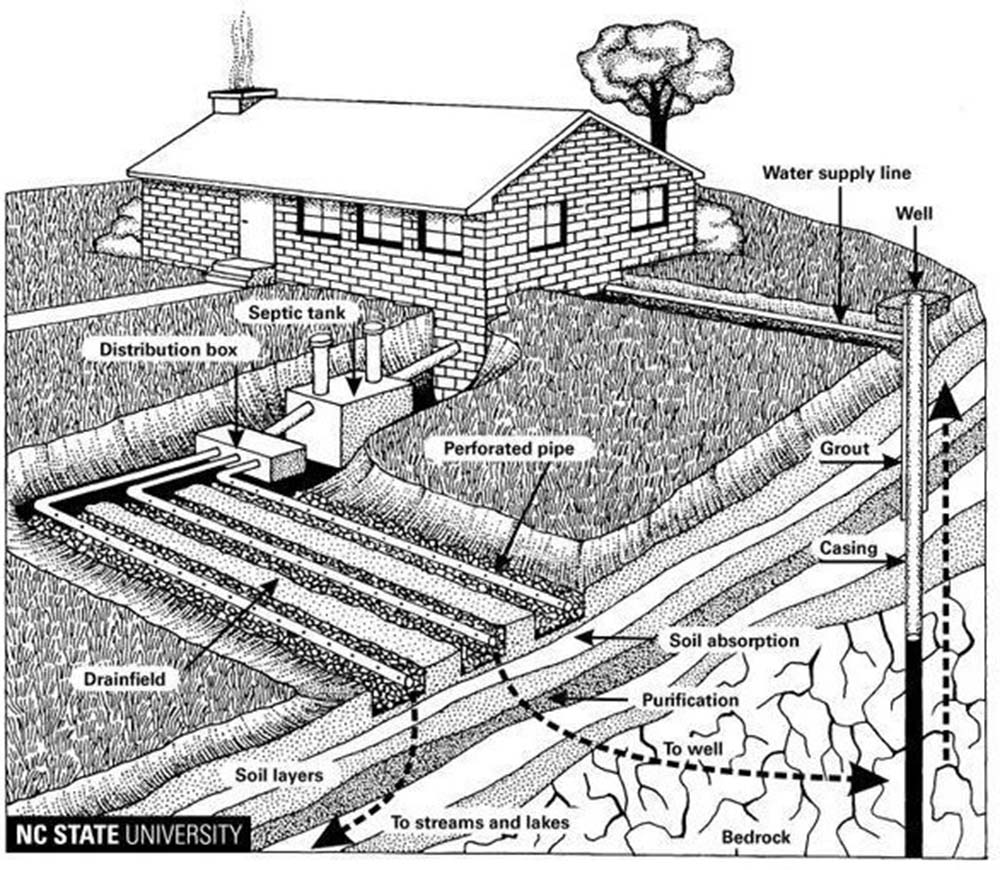Time for everyone’s favorite topic… okay, maybe not favorite.
If you own a home with a septic system then you already know how important they are to understand and maintain, but if you are thinking of buying then you need to understand what exactly it takes to keep the system running well, especially considering that nearly 50% of North Carolina homes have them.

The waste stays in the tank for a few days to allow bacteria to begin the process of breaking it down and then the effluent flows out of the tank where it is distributed through the drain field. As the effluent flows through the perforated pipes in the drain field the bacteria continue to do their work. The liquid is distributed through the holes into the soil. The soil continues to filter out the bacteria and absorb smaller germs and viruses, and then the clean water makes its way down to the water table.

There are 3 types of septic systems: Conventional, Pressure Distribution, and Aerobic Treatment Units. The conventional system is the most common in North Carolina and it works best with a gently sloping terrain and a deep water table below permeable soil.
If the soil is too rocky, contains too much clay, or the water table is too close to the surface then another system may be necessary.
A Pressure Distribution Septic System is similar to the Conventional system except it has a pump to help distribute the effluent through the drain field. These are used when the terrain is uneven or the soil conditions are not ideal.
An Aerobic Treatment Unit uses pumps and aerators to force more oxygen into the tank to help the bacteria break down the waste when the soil isn’t sufficient for the job.
You can find more information about the different types of septic tanks on the EPA website.
It is important to have your system inspected and maintained regularly.
Both the tank and the drain field should be inspected every three years, at least.
Because of the effects a septic system can have on the area’s fresh water system, in North Carolina inspectors must be certified by the North Carolina Onsite Wastewater Contractor Inspector Certification Board.
If you have a system other than a conventional one, you may need to have it inspected more frequently because of their mechanized parts.
When the sludge layer reaches about 25% to 33% of the tank then you need to have it pumped out. The frequency with which you have your tank pumped out will depend on three main factors, size of tank, wastewater generated by the household, and amount of solids in the wastewater. For example, a larger household that produces a lot of waste may need to be pumped out annually. While a single person household may be able to go 2 to 3 years between pumping. When you have the system inspected your inspector should be able to give you a good recommendation.
Pumping is important because over time the solids can accumulate to a level where they will overflow into the drain field and clog the pores of the drainage pipes. This is definitely something you will want to avoid, because if the soil in the drain field becomes too clogged then you may have to build a new drain field. If the thought doesn’t completely gross you out you can monitor the sludge level yourself. You can find The Sludge Judge on Amazon.
There are things you can do in between service visits to help keep your system healthy.
Conserve water: All the water you use goes into your system and it can overwhelm your drain field.
- High efficiency appliances, toilets and showerheads can reduce water use.
- Periodically check your plumbing for leaks. A dripping faucet can add nearly double your water output to the system.
- Choose the load size on your washing machine to match your actual load.
- Spread out your laundry loads through the week.
Don’t put all waste into the system: If it goes down your drain it enters your system.
- Only human waste and toilet paper should be flushed. Non-biodegradable items flushed down the toilet will build up and clog the system.
- Eliminate or limit what goes in the disposal. Food waste breaks down more slowly in the system, so this can build up your sludge layer quicker leading to more pump out needs.
- Your system runs on the bacteria that lives within it. Harsh chemicals, such as drain cleaners, oils, paint thinners, or other household chemicals can kill the healthy bacteria. Also, those chemicals can bleed out of the system into the groundwater.
Be careful of your drain field.
- Parking on the drain field can compact the soil and damage pipes.
- Laying concrete or blacktop above the drain field can hinder the necessary evaporation and the supply of oxygen into the soil.
- Tree roots can grow into and damage the pipes if they are planted too close.
- Your drain field should be for the septic system only. Avoid adding more water to the system by running rainwater runoff or sump pumps to the area
Septic systems are complex and require special knowledge and equipment from those who install and maintain them. The more education you can give yourself the better your system will run for you.

